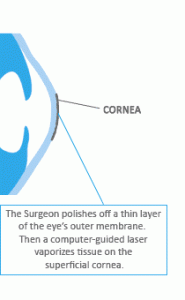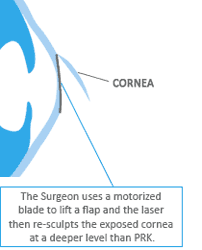Laser refractive surgery can be divided into two main categories: LASIK (laser insitu keratomileusis) and PRK (photorefractive keratectomy). Both use the laser in the same manner, but the initial aspects of the procedure are different between LASIK and PRK.
PRK
 PRK involves simply removing and polishing the surface layer of the eye (cornea). This reshapes the eye and corrects most refractive errors.
PRK involves simply removing and polishing the surface layer of the eye (cornea). This reshapes the eye and corrects most refractive errors.
Benefits
- It is a simple technique with very little surgical risk.
- No longterm flap risk – a consideration for certain situations (such as martial arts, construction, law enforcement, and dry eye syndrome).
- Surgery is on the top, superficial layer of the cornea, making it generally safer.
Things to Consider
- PRK has a slower recovery than LASIK – most people take one week off work; full vision recovery can take several weeks/months for some.
- Potentially more discomfort in first few days.
- Faint scarring may occur with strong treatments or re-treatments.
- Small risk of recurrent corneal erosion syndrome (i.e. awakening with irritation in the eye – may happen months after surgery).
Lasik
 Lasik is a more complex 3-step procedure:
Lasik is a more complex 3-step procedure:
- A flap is created and peeled to the side (like an orange peel)
- The laser removes tissue from the exposed area
- The flap is rolled back into position.
Benefits
- Fast, virtually painless recovery. Most people are able to return to work the next day.
- Less chance of either scarring or corneal erosion (surface breakdown) compared to PRK.
Things to Consider
- Potential for flap complications.
- Tissue is removed at a deeper level of the cornea, and there is a potentially greater risk to structurally weaken the eye compared to PRK.
- May be inappropriate to have permanent flap with certain jobs or hobbies: construction, military, martial arts.
